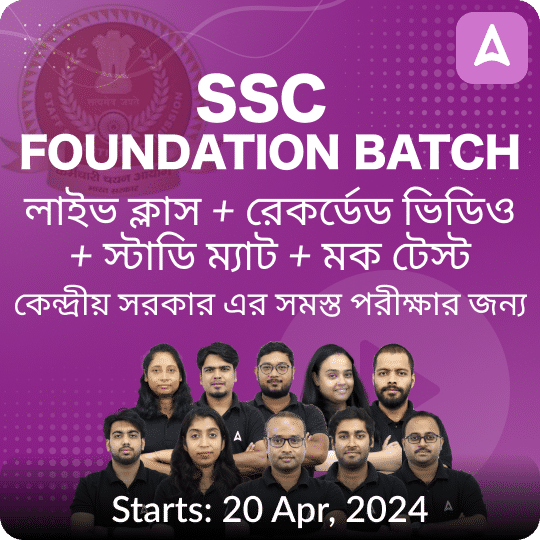Q1. জেনারালাইজড সিস্টেম অফ প্রেফারেন্স এবং মোস্ট ফেভার নেশন টার্ম সম্পর্কে নিম্নলিখিত বিবৃতি বিবেচনা করুন
- কোনও নেশন দ্বারা শুল্ক আরোপের ক্ষেত্রে এমএফএন স্ট্যাটাস সমান চিকিত্সা সরবরাহ করে তবে জিএসপির ক্ষেত্রে একটি দেশ কর্তৃক দেশের উন্নয়নের মর্যাদার উপর নির্ভর করে বিভিন্ন দেশকে পৃথক শুল্ক আরোপ করা যেতে পারে
- জিএসপি স্বল্পোন্নত দেশগুলির জন্য শুল্ক হ্রাস সরবরাহ করে তবে এমএফএন কেবলমাত্র ডব্লিউটিও সদস্যদের মধ্যে বৈষম্য না করার জন্য।
- ইউএনসিটিএডিএড এর নেতৃত্বে প্রতিষ্ঠিত জেনারালাইজড সিস্টেম অফ প্রেফারেন্স (জিএসপি)
উপরোক্ত বিবৃতিগুলির মধ্যে কোনটি সঠিক / কোনগুলি সঠিক?
(a)1, 2
(b)2,3
(c)1,3
(d)1,2,3
Q2. নেটওয়ার্কিং ফর গ্রিনিং দ্য ফিনান্সিয়াল সিস্টেম সম্পর্কিত নিম্নলিখিত বিবৃতিগুলি বিবেচনা করুন
- বিশ্ব ব্যাংক কর্তৃক ডিসেম্বর 2017 এ প্যারিস ওয়ান প্ল্যানেট শীর্ষ সম্মেলনে এনজিএফস চালু হয়েছিল
- একটি সাস্টেইনেবল অর্থনীতিকে সমর্থন করার জন্য মূলধারার আর্থিক ব্যবস্থাটি সচল করার লক্ষ্যে এটি চালু করা হয়েছে
- ভারতের রিজার্ভ ব্যাংক একটি আন্তর্জাতিক প্ল্যাটফর্মে এনজিএফএস-এ ভারতের প্রতিনিধিত্ব করে
উপরোক্ত বিবৃতিগুলির মধ্যে কোনটি সঠিক /কোনগুলি সঠিক?
(a)1, 2
(b)2,3
(c)2, 3
(d)1,2,3
Q3. যথাযথ কেওয়াইসি নিয়ম অনুসরণ না করে গ্রাহক সংযুক্ত যে কোনও পেমেন্ট ব্যাংক নিম্নলিখিত আইনের অধীনে আরবিআই দ্বারা দন্ডিত হতে পারে-
- ব্যাংকিং নিয়ন্ত্রণ আইন 1949
- আরবিআই আইন 1934
- পেমেন্ট এবং নিষ্পত্তি আইন 2007
সঠিক কোডটি নির্বাচন করুন
(a)1, 3
(b)2,3
(c)1,2,3
(d)3 only
Q4. সাম্প্রতিক মহামারীর প্রবাহের সময় ক্ষুদ্র ব্যবসায়ী ইউনিট, মাইক্রো ও স্মল ইন্ডাসট্রি এবং অন্যান্য অসংগঠিত খাত প্রতিষ্ঠানগুলিকে আরও বেশি সহায়তা দেওয়ার লক্ষ্যে আরবিআই 10,000 কোটি টাকার বিশেষ দীর্ঘমেয়াদী রেপো অপারেশন পরিচালনা করার সিদ্ধান্ত নিয়েছে নিম্নলিখিতগুলির জন্য রেপো হারে-
(a) আরবান কোঅপারেটিভ ব্যাংক
(b) রিজিওনাল রুরাল ব্যাংক
(c) ডিস্ট্রিক্ট কোঅপারেটিভ সোসাইটি
(d)স্মল ফিনান্স ব্যাংক
Q5. রেগুলেশন রিভিউ অথরিটি আরআরএ) সম্পর্কিত নিম্নলিখিত বিবৃতিগুলি বিবেচনা করুন
- সম্প্রতি নিয়মকানুনকে সহজতর করার জন্য এবং নিয়ন্ত্রিত সংস্থাগুলির সম্মতি বোঝা হ্রাস করার জন্য এটি অর্থ মন্ত্রক দ্বারা গঠিত হয়েছে।
- এস জনকিরামান, উপদেষ্টা দলটি নিয়মাবলী, নির্দেশিকা এবং যুক্তিযুক্ত হতে পারে এমন রিটার্নগুলি সনাক্ত করে আরআরএকে সহায়তা করবে
- এম রাজেশ্বর রাওকে রেগুলেশন রিভিউ অথরিটি হিসাবে নিয়োগ দেওয়া হয়েছিল।
উপরোক্ত বিবৃতিগুলির মধ্যে কোনটি সঠিক / কোনগুলি সঠিক?
(a)1, 3
(b)2,3
(c)1,2,3
(d)3 কেবল
Q6. প্রম্পট কারেক্টিভ অ্যাকশন (PCA) ফ্রেমওয়ার্কের অংশ হিসাবে রিজার্ভ ব্যাংক নির্দিষ্ট নিয়ন্ত্রক ট্রিগার পয়েন্টগুলি নির্দিষ্ট করেছে। নিম্নলিখিতগুলির মধ্যে কোনটি
- ক্যাপিটাল টু রিস্ক-ওয়েটেড অ্যাসেট রেশিও (CRAR)
- নেট নন- পারফর্মিং অ্যাসেট (NPA)
- রিটার্ন অন অ্যাসেট (RoA)
- কমন ইক্যুইটি টায়ার -I
সঠিক কোডটি নির্বাচন করুন
(a)1, 2
(b)2,3,4
(c)1,2,3
(d)1,2,3,4
Q7. আর্থিক স্থায়িত্ব ও উন্নয়ন কাউন্সিল (এফএসডিসি) সম্পর্কিত নিম্নলিখিত বিবৃতিগুলি বিবেচনা করুন
- এটির সভাপতিত্ব করছেন ভারতের রিজার্ভ ব্যাংকের গভর্নর
- এটি রঘুরাম রাজন কমিটি (2008) এর সুপারিশক্রমে 2010 সালে একটি অ-সংবিধিবদ্ধ শীর্ষ স্তরের সংস্থা গঠন।
- এটি ভারতের রিজার্ভ ব্যাংকের তত্ত্বাবধানে কাজ করে
উপরোক্ত বিবৃতিগুলির মধ্যে কোনটি সঠিক /কোনগুলি সঠিক?
(a)1, 3
(b)2,3
(c)1,2,3
(d)2 কেবল
Q8. নিম্নলিখিতগুলির মধ্যে কোনটি আর্থিক স্থিতিশীলতার প্রতিবেদন প্রকাশ করে?
(a) অর্থ মন্ত্রক
(b) এমওএসপিআই
(c) আরবিআই
(d) অর্থ কমিশন
Q9. নিচের কোনটি দ্বারা গ্লোবাল ইকোনমিক প্রসপেক্টস রিপোর্ট প্রকাশ করেছে –
(a) আইএমএফ
(b) ওয়ার্ল্ড ইকোনমিক ফোরাম
(c) বিশ্বব্যাংক
(d) এডিবি
Q10. নেট স্টেবল ফান্ডিং রেশিও সম্পর্কিত নিম্নলিখিত বিবৃতি বিবেচনা করুন
- এনএসএফআরের উদ্দেশ্য হ’ল ব্যাংকগুলি তাদের সম্পদ এবং অফ-ব্যালান্স শিটের ক্রিয়াকলাপের ক্ষেত্রে স্থিতিশীল তহবিলের প্রোফাইল বজায় রাখা নিশ্চিত করে।
- এনএসএফআর নির্দেশিকাগুলি অর্থ মন্ত্রনালয় তৈরি করে
উপরোক্ত বিবৃতিগুলির মধ্যে কোনটি সঠিক / কোনগুলি সঠিক?
(a) কেবল 1
(b) কেবল 2
(c) 1 এবং 2 উভয়ই
(d) 1 বা 2 কোনোটিই নয়
Solutions
S1.Ans.(d)
Sol.
The Generalized System of Preferences (GSP), instituted in 1971 under the aegis of UNCTAD, has contributed over the years to creating an enabling trading environment for developing countries. The following 13 countries grant GSP preferences: Australia, Belarus, Canada, the European Union, Iceland, Japan, Kazakhstan, New Zealand, Norway, the Russian Federation, Switzerland, Turkey, and the United States of Americ
The Generalized System of Preferences, or GSP, is a preferential tariff system that provides tariff reductions on various products. The concept of GSP is very different from the concept of “most favored nation” (MFN). MFN status provides equal treatment in the case of the tariff being imposed by a nation but in the case of GSP differential tariff could be imposed by a nation on various countries depending upon factors such as whether it is a developed country or a developing country. Both the rules come under the purview of WTO.
GSP provides tariff reduction for least developed countries but MFN is only for not discriminating among WTO members.
Source: https://unctad.org/topic/trade-agreements/generalized-system-of-preferences
S2.Ans.(c)
Sol.
At the Paris “One Planet Summit” in December 2017, eight central banks and supervisors established the Network of Central Banks and Supervisors for Greening the Financial System (NGFS). Since then, the membership of the Network has grown dramatically, across the five continent
As of June 1st, 2021, the NGFS consists of 91 members and 14 observers.
Reserve Bank of India (RBI) has recently joined as a member of the Central Banks and Supervisors’ Network for Greening the Financial System (NGFS).
NGFS consists of a group of central banks and supervisors willing, on a voluntary basis, they will share best practices and experiences for the development of environment and climate risk management in the financial sector. • The central Banks will organize the finance to support the transition towards a sustainable economy. RBI as a member will contribute to global efforts on green finance and climate change
https://www.ngfs.net/en/about-us/membership
S3.Ans.(d)
Sol.
As per the PSS act, 2007 RBI can penalize PPIs for the following list of contraventions
Imposition of monetary penalty for RBI identified contraventions
(i) An indicative list of the contraventions/violations is as under:
- Wilful submission of a false statement of information or wilful omission of a material statement to RBI; b. Delay / non / incomplete / incorrect submission of various statutory / regulatory returns / statements / documents, etc.;
- Contravention of any provisions of the Act or of any regulation, directions/instructions made thereunder;
- Issues in the maintenance of net worth requirements, etc.
- Non-compliance with Know Your Customer (KYC) and Anti-Money Laundering (AML) norms;
- Issues in the maintenance of nodal / escrow accounts; g. Breach of limits in loading, fund transfer, etc. of PPIs;
Source: https://rbidocs.rbi.org.in/rdocs/notification/PDFs/NT140FEA1CD3EEB3447D390B7672041D80825.PDF
S4.Ans.(d)
Sol.
The Reserve Bank of India (RBI) conducted the first auction for special long-term repo operations (SLTRO) of Rs 10,000 crore for Small Finance Banks (SFBs) on May 17.
In a bid to provide further support to small business units, micro and small industries, and other unorganized sector entities adversely affected during the current wave of the pandemic, the RBI has decided to conduct an SLTRO of Rs 10,000 crore at the repo rate for the SFBs, to be deployed for fresh lending of up to Rs 10 lakh per borrower.
S5.Ans.(b)
Sol.
The Reserve Bank of India’s (RBI) Regulations Review Authority (RRA 2.0) has constituted a 6- member Advisory Group headed by S Janakiraman, Managing Director of State Bank of India to support in reviewing the RBI’s regulations and compliance procedures to streamline/rationalize them to make them more effective
The RRA will review the regulatory prescriptions internally as well as by seeking suggestions from the RBI-regulated entities and other stakeholders on their simplification and ease of implementation.
Reserve Bank of India Deputy Governor M Rajeshwar Rao was appointed as the Regulations Review Authority.
S6.Ans.(c)
Sol.
The Reserve Bank has specified certain regulatory trigger points, as a part of prompt corrective action (PCA) framework, in terms of three parameters, i.e. capital to risk-weighted assets ratio (CRAR), net non-performing assets (NPA), and Return on Assets (RoA), for initiation of certain structured and discretionary actions in respect of banks hitting such trigger points. The PCA framework is applicable only to commercial banks and not extended to cooperative banks, non-banking financial companies (NBFCs), and FMIs.
Source: https://rbidocs.rbi.org.in/rdocs/PublicationReport/Pdfs/PCAFR060514_4.pdf
S7.Ans.(d)
Sol.
News: Union Minister for Finance has chaired the 22nd Meeting of the Financial Stability and Development Council(FSDC).
- Financial Stability and Development Council(FSDC): It is a non-statutory apex level body setup in 2010 on the recommendations of the Raghuram Rajan Committee(2008).
- It works under the aegis of the Ministry of finance
- Objectives: Tostrengthen and institutionalize the mechanism for maintaining financial stability, enhancing inter-regulatory coordination, and promoting financial sector development.
- Functions: It is charged with financial literacy, financial inclusion, and macro-prudential supervision of the economy, including the functioning of large financial conglomerates.
- Chairman: Union Finance minister
- Members: a) Heads of Financial Sector Regulators (RBI, SEBI, PFRDA & IRDA) b) Secretaries of various Departments c) Chief Economic Adviser d) Minister of state responsible for the Department of Economic Affairs(DEA) e) Chairperson of the Insolvency and Bankruptcy Board of India (IBBI) among others.
- Source: https://www.rbi.org.in/Scripts/BS_PressReleaseDisplay.aspx?prid=50949
S8.Ans.(d)
Sol.
RBI releases this.
Source: https://www.rbi.org.in/Scripts/BS_PressReleaseDisplay.aspx?prid=50949
S9.Ans.(c)
Sol.
It is published by RBi
Source: https://www.worldbank.org/en/publication/global-economic-prospects
S10.Ans.(a)
Sol.
- The objective of NSFR is to ensure that banks maintain a stable funding profile in relation to the composition of their assets and off-balance sheet activities.
- NSFR guidelines are framed by the Ministry of Finance
- NSFR limits reliance on short-term wholesale funding encourages the better assessment of funding risk across all on- and off-balance sheet items and promotes funding stability.
- On March 27, the RBI had deferred the implementation of NSFR guidelines by six months and it was to take effect from October 1.
- Source: https://www.thehindubusinessline.com/money-and-banking/rbi-offers-relief-on-buffer-stable-funding-ratio-norms/article32725808.ece









